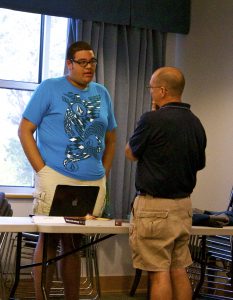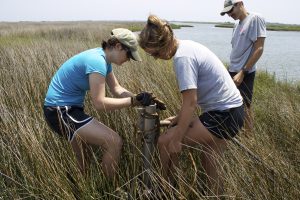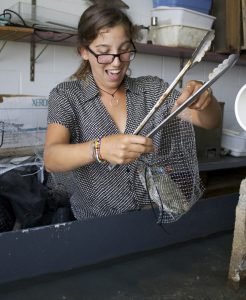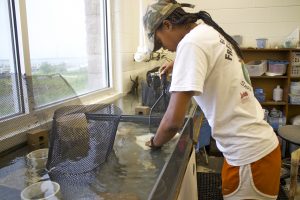2014 REU Projects
2014 REU Research Projects
Austin Edmonds (Barton College)
Meiofaunal community structure associated with sediment strata and depth in an exposed beach
Abstract: Meiofaunal species are ubiquitous and abundant in exposed beaches globally. Their functional roles within this habitat are not well known but some studies suggest they exert top-down influences on the populations of primary producers (diatoms) and decomposers (bacteria) in beaches through consumption. As exposed beaches erode due to sea level rise and humans respond by nourishing the beaches, over time beach nourishment creates layers of shell hash which is a larger sediment than the native normal fine and medium sand. Meiofauna are known from other benthic habitats to be affected by changes in sediment composition. In this study, the comparison of meiofauna abundance with depth comparing shell versus sand were analyzed. Along with this is the comparison of modern and historical data collected on meiofauna abundance in general and in shell vs. sand. Sampling for meiofauna and grain size analysis was done by digging vertical pits and extracting horizontal cores from discrete strata of sediment in the lower intertidal area of the beach. Subsurface shell hash in the beach at low tide height now comprises >70% by volume of all sediments (versus ~15% historically). Shell hash at depth had significantly lower abundances of nematodes, turbellaria, and harpacticoid copepods than fine to medium sand at the same depth. There were also significant relative changes in community composition. Coarsening of the beaches is altering meiofauna community structure with depth. These changes in absolute and relative abundances may affect the functional roles of the meiofauna in exposed beach.
Steven Moran (Methodist University)
Comparative analysis of Vibrio abundance and virulence gene frequencies between Mercenaria mercenaria and Crassostrea virginica in North Carolina
Abstract: Vibrio parahaemolyticus and Vibrio vulnificus are two pathogenic species of Vibrio that are capable of causing human disease and infection. In this study, two filter-feeding bivalves collected from the same location, the hard clam, Mercenaria mercenaria, and the oyster, Crassostrea virginica, were tested for the presence and virulence of V. parahaemolyticus and V. vulnificus. Clams and oysters were aseptically processed and their homogenates were plated onto selective media to grow bacterial colonies for subsequent testing. The bacterial colonies were then tested for virulence using polymerase chain reaction (PCR). Vibrio spp. were presently more frequently in oyster tissues than in clam tissues when the water temperature was above 20°C (in cooler spring temperatures this pattern is reversed). There were more virulent and avirulent strains of V. vulnificus than V. parahaemolyticus in both clam and oyster tissues. There was no relationship between the presence of virulent strains of Vibrio in shellfish tissue and virulent strains of Vibrio in water samples collected in the field. When water temperatures warm the concentrations of Vibrio in filter feeders increases, more in oysters than clams.
Caroline White-Nockleby (Williams College)
Examining the blue carbon cycle on a transgressive barrier island
Abstract: This study aimed to better understand how carbon sequestered in barrier islands fits into a larger context of the carbon cycle, and how this may change over human timescales. Back-barrier marshes sequester carbon; as plants and other organisms die, much of their carbon is buried and stored underneath living marsh vegetation. Increased rates of sea-level rise is leading to decreases in back-barrier marsh area as island landward migration rates and erosion rates of the marsh-estuarine shoreline increase, which has the potential to decrease carbon storage. I took cores along transects at three different sites on the southern half of Core Banks, NC; two at paleo-inlet sites (Goose and Great islands) and one from a marsh situated on top of washover deposits. Using data obtained from GPS measurements, CHN analysis of core sedimentary facies, and satellite photos, I estimated the amount of carbon in a 1-m wide transect at each site, and then extrapolated for the entire paleo-inlet area. Carbon profiles of the cores showed that there is 5.19 to 13.94% carbon by weight contained in the marsh unit of the paleo-inlet transects. I then put these values, age estimates of the marsh from old maps, ocean shoreline erosion rates, and estuarine shoreline erosion rates into a model of carbon import and export. I changed the parameters of the model to reflect varying levels of erosion for different projected rates of sea-level rise. Model results show that with current erosion rates, both Goose and Great Island marshes will serve as carbon sinks for the next 500 to 1000 years. However, doubling the rate of erosion to reflect trends in sea-level rise and storm severity causes the marshes to switch from net carbon sinks to sources in 10 to 100 years. Increasing erosion rates also speeds the rate of inlet formation, making both transects vulnerable to inlet breaching hundreds of years sooner than they would be under constant sea-level rise conditions. Over human timescales, these changes could decrease the amount of sequestered carbon and increase the amount of CO2 that enters the ocean or atmosphere, potentially contributing to global climate change.
Marjorie Howard (Gettysburg College)
Impacts of Rangia cuneata on the phytoplankton community structure and water quality of the Neuse River Estuary, North Carolina
Abstract: This study investigated the impacts of the wedge clam, Rangia cuneata, as a top-down control on the phytoplankton community in the Neuse River Estuary. Population density of R. cuneata was determined at Flanners Beach, the site on the Neuse River from which clams were collected using quadrats. Filtration rate of R. cuneata was calculated based on the clams’ reduction of chlorophyll-a concentrations in 3.5L containers over a 12-hour period. High-performance liquid chromatography (HPLC) was used to determine the species of phytoplankton filtered from the water based on the concentration of algal photopigments, through analysis of both the water over time and the clams’ stomach contents. Nutrient analysis was additionally performed to determine the clams’ impact on ammonium and phosphate concentrations in the water. The filtration rate was determined to be 1.43 L h-1 g-1 (grams of dry tissue weight, similar to that found in a previous study. The HPLC results did not indicate selective feeding, as the filtration rates of all pigments were not significantly different, and pigments found in the clams’ stomachs reflected the initial concentration of pigments in the water. The containers with clams experienced a significant increase in ammonium concentration; an increase was also seen in phosphate concentration, though it was not significant. The density measurement obtained at Flanners Beach was 5.38 clams m-2, which was considerably lower than densities found in other estuaries. The clams’ impact on the estuary would be limited by the low densities I observed; however, a more accurate estimate of abundance and distribution is necessary and could indicate a shorter clearance time as well as a higher overall impact on the Neuse River Estuary.
Meg Schmitt (Grinnell College)
High-order consumers alter Panopeus herbstii behavior and nonconsumptive effects protect a shared prey, Mercenaria mercenaria
Abstract: Nonconsumptive effects are changes in the abundance of a species as result of changes in its behavior, growth, or reproduction due to the mere presence of a predator. Under some conditions, nonconsumptive effects on a mesopredator by a higher-order predator can affect the abundances of the mesopredator prey. I investigated these complex interactions using laboratory mesocosms in which I placed prey (juvenile hard clams, Mercenaria mercenaria), a mesopredator (mud clams, Panope sp.), and a higher order predator (either a blue crab, Callinectes sapidus or a stone crab, Menippe mercenaria). Replicate trials were conducted for 24 hr and then the change in prey abundance was determined for each of several treatment combinations (mesopredator without higher order predator, mesopredator with a blue crab, and mesopredator with a stone crab; in all cases the chelae of the higher order predators were bound to prevent mesopredator predation. Significantly fewer clams were consumed by the mesopredators when a higher order predator was present. The sizes of both the higher order predator and mesopredator affected clam consumption, but gender did not. Stone crabs suppressed mesopredator consumption more than blue crabs. The results indicate that interactions among species on different trophic levels do occur and can influence prey survival.
Taylor Renée Burns (Loyola University New Orleans)
Trait mediated movements of fish across fragmented landscapes
Abstract: The distribution and relative sizes of patches of habitat can affect the structure of biological communities inhabiting the respective patches of habitat. As an example, species richness of small, forage fish decreases in fragmented seagrass patches over contiguous seagrass patches even if total areal coverage of the seagrass remains constant. The processes producing these patterns are not well understood. In this study, I varied the degree of seagrass fragmentation, presence and absence of piscine predators, and the body traits (camouflaged versus shiny) of different species of prey fish in mesocosms and quantified the # of movements of the prey fish among patches. There were no significant differences among patterns of movement among species within a body trait category. Camouflaged fish moved significantly less across seagrass-sand borders than shiny fish, regardless of whether a predator was present or not, and consequently camouflaged fish were less likely to move among patches. The proportion of fish within seagrass patches did not differ for either body type unless a predator was present, where significantly fewer shiny fish were in the seagrass patches. More effort examining the role of different patches of fragmented habitat need to be done, but trait-mediated differences do exist for determining movement patterns among fish species.
Laura Dobroski (Lehigh University)
Effects of warming and nutrient enrichment on trophic production in coastal waters
Abstract: The effects of temperature on the metabolism and body size of individual organisms has been well studied. The accumulated effects of temperature changes on individuals upon ecosystem structure and processes, such as trophic webs and production, are less well understood. In separate cubitainers, I varied combinations of temperature (ambient, ambient + 3°C, and ambient + 5°C) and nutrients (ambient, ambient + 20 µm N and 1 µm P, and ambient + 40 µm N and 2 µm P) in otherwise unmanipulated samples of Bogue Sound water. After 1, 2, and 4 days of exposure to ambient light levels the concentrations of chlorophyll a and zooplankton biomass were measured from each treatment replicate. Nutrient addition (at either level) led to significant increases in chlorophyll a concentration on day 1, but less on day 2, and even less on day 4. As zooplankton biomass did not differ significantly by day 4 among treatments (although they did trend higher with higher nutrient additions) the observed decrease in chlorophyll a concentration through time may have resulted from a functional increase in zooplankton consumption. Neither chlorophyll a concentrations nor zooplankton biomasses differed among temperature regimes, although a marginal increase in both measures was associated with higher concentrations of nutrients. For the levels of nutrient and temperatures used in this study, nutrients had the greatest effects on phytoplankton and zooplankton biomasses. There was some indication of change from bottom up to top down control of the plankton community.
Allison Haddon (Western Carolina University)
Decadal patterns in salinity regimes near Beaufort Inlet, North Carolina associated with historical changes in climate and anthropogenic activity
Abstract: Salinity is a fundamental, forcing factor in coastal systems affecting directly both the physical movements of water and the distributions and abundances of organisms. Within estuaries the introduction of freshwater from terrestrial sources and of high salinity water from oceanic sources determines the location and patterns of isohalines. As climate patterns change and humans modify coastal structures (e.g., dredging of inlets) centuries long patterns of isohalines in estuaries may change. I used both historical and contemporary data from salinity databases, US Army Corps of Engineers dredging records, water level records, and terrestrial drought indices (Palmers Drought Severity Index = PDSI) to examine changes in salinity in estuaries near and far from Beaufort Inlet, NC over decadal time scales. A significant, positive linear relationship was found between mean tidal range and depth of dredging in Beaufort Inlet. Salinity records before and after the inlet depth was increased (and maintained) in the early 1970’s indicated an increase in mean salinity in waters near the inlet but not in those further in distance (>100 km). Analysis of the PDSI indicated that some of the salinity increase can be explained by decreasing freshwater input locally in the 1970’s and 1980’s, but not in the last 25 years. In the shallow sounds and estuaries in the Beaufort, NC region changes in inlet depth may determine salinity more than long-term freshwater inputs because of the large, daily influxes of seawater.
Go to 2013 REU Projects











